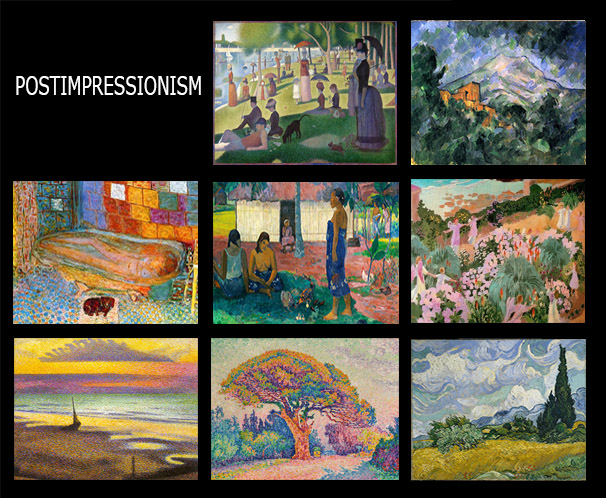
Post-Impressionism 00
written by artinthefridge
Post-Impressionism
Post-impressionism is a movement whose origin and development are linked to the meeting of French painters at the Salon des Indépendants in Paris in 1884. They took the name out of respect for their predecessors, the Impressionists. The movement's principal artists were Paul Cézanne, Paul Gauguin, Vincent van Gogh, and Georges Seurat.
The main directions of the postimpressionist movement were neo-impressionism, nabism, divisionism (pointilism), symbolism, and synthetism, along with some ongoing impressionists' work.
Paul Cézanne (1839 – 1906)
In contact with the Impressionists, Paul Cézanne learned the charm of plein-air painting and the value of the phenomena of light and atmosphere, as well as the possibility of expression through pure coloristic means. He exhibited with them in 1874 at their first exhibition, then decisively broke with them and set out on an uncompromising search for his own expression, which will forever remain the main feature of his creation.
It was only in 1900, during the exhibition One Hundred Years of French Painting, that the public and critics began to understand the greatness and significance of his work. The synthesis, which he realized as his knowledge of the essence of painterly expression in forms and colors, marks a decisive turning point in the history of painting.
Paul Gauguin (1848- 1903)
In the initial phase of his artistic creation, Gauguin was influenced by the Impressionists. Foreseeing the crisis of impressionism as an analytical method that leads to the dissolution of the integrity of the image, Gauguin opposes it with the idea of painting as a synthesis in which the elements of form and color will be summarized and elevated to monumentality.
Gauguin's technique is the technique of painting from memory; in nature, he only makes sketches; the work ends in the studio. Because of this, his paintings became more decorative and less realistic.
Gauguin was an important figure in the post-impressionist and later symbolist movements as a versatile artist (painter, sculptor, printmaker, ceramist, and writer). His artistic expression paved the way for primitivism and a return to pastoralism.
Vincent van Gogh (1853- 1890)
With his complex and problematic life and his artistic expression, Van Gogh became a legend of modern art. He originally drew and paints people disfigured by hard work. These drawings and paintings were made by the consciousness of a sensitive nature, which in life felt isolation and anxiety from early on and lived through crises in turn. Sam confesses to his brother: "I want to express a sincere human feeling. And it's not my goal to like this or that."
In the four years before his death, van Gogh experienced a great evolution: he discovered impressionists, neo-impressionists, Japanese multicolored woodcuts. His gloomy palette changes radically, receiving fresh, open colors, and the form becomes decorative with underlined graphics.
V. van Gogh is the predecessor of the entire European expressionism in that he passionately tried to express in his paintings what cannot be expressed. He was one of the first artists who deformed the natural form in order to achieve the strongest and most intense expressiveness.
Divisionism
(French - divisionisme, from Latin dividere - to divide)
technique in painting, which was pioneered by impressionists (C. Monet, C. Pissaro, A. Sisley);
they leave the spread of mixed colors and build the image from smaller spots or dots of color, which compose the desired secondary color. With this process, they achieve the impression of vibrating atmosphere, specific to the impressionist way of painting.
The mentioned technique was deepened and applied by Georges Seurat and Paul Signac, dividing tones into three basic colors: yellow, red, blue. Properly arranged and viewed from a distance, these colors give the appearance of a certain mixed or secondary tone; pouring should only happen in the eye of the beholder.
Seurat and Signac are joined by H.-E. Cross, Ch. Angrand and A. Dubois-Pillet.
Divisionism, which is sometimes called pointillism (French pointillisme), is an important characteristic of neo-impressionists.
Nabism
The word Nabis derives first from Hebrew word (nabiim) and means "prophets". This group was mainly composed of French post-impressionist avant-garde artists. They were active in Paris from 1888 until about 1900. It is interesting that among the members of the movement there were not only painters but also sculptors and poets.
Pierre Bonnard is with Maurice Denis, Eduard Vuillard, F.-E. Together with Valloton and the sculptor A. Maillol, the founder of the Nabis group, which in the post-impressionist phase of French painting at the end of the 19th century expressed symbolist tendencies in composition. Bonnard does not follow this group in the turn towards the decorative, but rather directs himself towards artistic expression, characterized as intimacy.
While in the post-impressionist development, the personalities and attitudes of P. Cezanne, V. van Gogh and E. Munch represent turning points and inaugurate new ways of approaching painting issues, Bonnard remains consistent with his lyricism.
It is fundamental to specify that the Nabis did not give priority to the theme of the work but to inner expression. The colors, placed in relation to each other, determined an agreement aimed at expressing a unique and unrepeatable meaning.
It is possible to make a distinction of orientations within the Nabis group. The first, deeply sacred, was led by Maurice Denis and his desire to renew religious art. He took as his point of reference the works from the primitive simplification of Paul Gauguin.
The second orientation is instead the secular one, influenced by Edgar Degas, where to be portrayed are subjects of modern life as elegant women and bourgeois interiors. The best representatives in this regard were Bonnard and Vuillard.
The Painter's Eye by Maurice Grosser, 1956
History Of Art – H. W. Janson, 1967
History of Modern Art by H.H. Arnason, 1968
ArtintheFridge, September 2022
Links to other articles:
Modern Art
https://www.fxhash.xyz/article/modern-art-00
Impressionism
https://www.fxhash.xyz/article/impressionism-00
Fauvism
https://www.fxhash.xyz/article/fauvism
Cubism
Expressionism